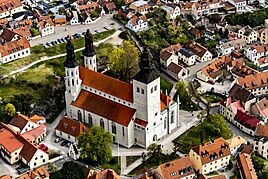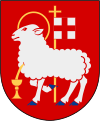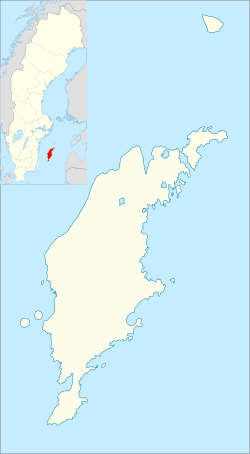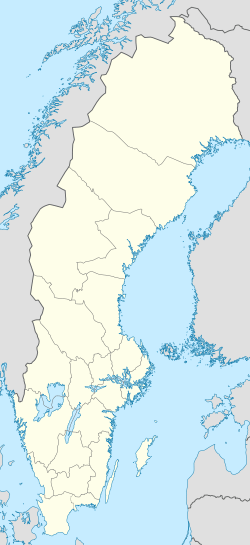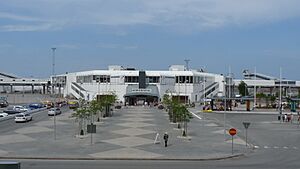Visby facts for kids
Quick facts for kids
Visby
Böi or Böin (Gutnish)
|
||
|---|---|---|
|
Clockwise from top: the Visby Cathedral; ruins of the Saint Nicolai Church; Almedalen
|
||
|
||
| Nickname(s):
City of roses
|
||
| Country | ||
| Province | ||
| County | Gotland County | |
| Municipality | Gotland Municipality | |
| Charter | 1645 | |
| Area | ||
| • Locality | 12.44 km2 (4.80 sq mi) | |
| Population
(31 December 2017)
|
||
| • Locality | 24,330 | |
| • Density | 1,816/km2 (4,700/sq mi) | |
| • Metro | 58,003 | |
| Time zone | UTC+1 (CET) | |
| • Summer (DST) | UTC+2 (CEST) | |
| Postal code |
621 xx
|
|
| Area code(s) | (+46) 498 | |
| UNESCO World Heritage Site | ||
| Official name | Hanseatic Town of Visby | |
| Criteria | Cultural: iv, v | |
| Inscription | 1995 (19th Session) | |
Visby is a town in Sweden. It is the main town on the island of Gotland. About 24,330 people lived there in 2017. Visby is famous for its history. It is one of the best-preserved medieval cities in Scandinavia.
Since 1995, Visby has been a UNESCO World Heritage Site. This means it is a very important historical place. The town has a long city wall that is about 3.4 kilometers long. It also has many old church ruins. Because it was not a major city later on, many of its old stone houses stayed in their original medieval style.
Visby is a popular place for holidays, especially in summer. Thousands of tourists visit every year. It is the largest town in Sweden not on the mainland. Gotland University is in Visby. It is now part of Uppsala University. Visby is also the only county seat in Sweden that you can only reach by boat or plane from the mainland.
A big event held in Visby is the Almedalen Week. This is a meeting for Swedish politicians.
Contents
What's in a Name?
The name "Visby" comes from old words. "Vis" means "place of sacrifices" (for pagan gods). "By" means "village". So, Visby means "village of the holy place". In an old story from the 1300s, the place was just called Wi. This meant "holy place" or "place of worship".
Visby is also known by two nicknames. People sometimes call it "The City of Roses". Others call it "The City of Ruins".
Visby's Past
The very first history of Visby is not fully known. But we know it was a busy trading center around the year 900 AD. People lived here even in the Stone Age. This was probably because it had fresh water and a natural harbor. The oldest things found in Visby are "beach huts". Scientists say they are from the 7th to 9th centuries AD.
In the 1100s, Visby Cathedral was built. It was for Saint Mary. It was changed to look like it does today in the 1200s. The church officially opened in 1225. Many other churches were built in the years that followed. The city grew rich and powerful. This was thanks to the Hanseatic League. This was a group of trading cities in Europe.
Work on the city wall probably started in the 1100s. Around 1300, it was made taller and got its famous towers. Some towers were added later, in the 1400s. Most of the wall is still standing today.
From 1300 to 1350, Visby was very wealthy and important. During this time, the Laws of Wisbuy were likely created. These were sea laws that were used in the Baltic Sea and beyond.
In 1361, Valdemar IV of Denmark attacked and took over Gotland. About 1,800 Gotlanders died fighting outside the city. Valdemar broke down part of the city wall. He demanded that the city fill three large barrels with silver and gold. If they didn't, his soldiers would rob the town. The people of Visby paid him, even taking valuables from churches. Valdemar then called himself "King of Gotland". His actions made the Hanseatic League angry. They went to war with Denmark. But Valdemar kept Visby as a Danish city.
Later, pirates called the Victual Brothers attacked and robbed Visby in 1391, 1394, and 1398. An army of Teutonic Knights then took over Gotland in 1398. They destroyed parts of Visby and drove out the pirates. In 1409, the Teutonic Knights sold Gotland to Queen Margaret. She was the queen of Denmark, Norway, and Sweden.
In 1411, King Eric of Pomerania built the Visborg castle. He lived there for 12 years. During this time, Visby became a pirate hideout. Trade almost stopped. By 1470, the Hanseatic League removed Visby from its list of Hanseatic towns.
In 1525, another big problem happened. There was a fight for the Danish throne. Lübeck, a powerful German city, supported one king. Søren Norby, the Danish leader of Gotland, supported another. While Norby was fighting in Sweden, the people of Lübeck attacked Visby. They set the city on fire in four places. Many churches were damaged or destroyed. After this, and with the Reformation, most churches were closed. Only St. Mary's Cathedral remained open. It became the main church for the city.
Gotland became part of Sweden again in 1645. This happened after 300 years of Danish rule. The city grew slowly after this. In the mid-1700s, after a plague reduced Visby's population, some efforts were made to improve the city. But not much changed. Visby only started to become important for trade and harbor work again in the early 1800s. In 1808, Russia took over Gotland. But the Swedes took it back peacefully after only a few months.
Where is Visby?
Visby is both the name of the town and the larger area around it. Visby is the only place on Gotland that has historical "city status". Visby is also the only main town in Sweden that you can only reach by boat or plane from the mainland.
Visby is on the central west coast of Gotland. It sits on steep limestone cliffs. The town grew around its first natural harbor. This old harbor is now the Almedalen park. Long streets run along the old shoreline. Shorter streets go up the slope to the higher eastern part of town, called Klinten.
The old part of Visby is mostly surrounded by the city wall. The old harbor and the Baltic Sea are to the west. The newer parts of town are mostly east of the wall, further inland. South of the wall, along the shore, is the modern harbor. This is where the ferries arrive. Further south is a green area called Södra Hällarna. There are several beaches near Visby. These include Kallbadhuset, Norderstrand, and Snäckgärdsbaden.
Visby and Tallinn (in Estonia) are special. They are the only two cities in Northern Europe where the medieval street plan is still fully preserved today.
An asteroid in space, called 6102 Visby, is named after this town.
Weather in Visby
Visby has an oceanic climate. This means its summers are cooler and its winters are milder than most of mainland Sweden. However, the weather can also be affected by air coming from the land. It does not rain or snow a lot in Visby. The rainfall is spread out evenly through the year. Visby is also one of the sunniest towns in Sweden. It gets a lot of sunshine, especially in summer.
Getting Around Visby
You can get to Visby from mainland Sweden by ferry or by plane. Ferries come from Oskarshamn and Nynäshamn. The trip takes about three hours. Destination Gotland runs these ferries.
Visby Airport is about 5 kilometers north of the city. It has flights to the Swedish mainland. In 2018, it was the 9th busiest airport in Sweden. Daily flights to Stockholm Arlanda Airport are a common way to travel to or from Gotland.
Visby also has city buses. There are also buses that go to other parts of Gotland.
Visby used to have two railway lines. One went from Lärbro in the north to Burgsvik in the south. The other went south to Visborgsslätt. Passenger trains stopped running in 1960. The last parts of the railway tracks in Visby were removed in 1964. The old Visby railway station is still there. It is just south of Söderport.
Things to See and Do
In the first week of July, Visby hosts the Almedalen Week. This is a very important meeting for Swedish politics. During this week, leaders from Sweden's main political parties give speeches in the Almedalen park.
August is the busiest time for tourists. In the second week of August, the annual Medieval Week on Gotland takes place. During this week, many visitors dress up in medieval costumes. The festival started in 1984. It includes music, jesters, theater, a medieval market, and jousting tournaments.
The main office of the World Ecological Forum is also in Visby.
Culture and Arts
Visby is home to special centers for writers and composers. These are the Baltic Centre for Writers and Translators and the Visby International Centre for Composers.
Sports in Visby
Visby has several sports clubs:
- Endre IF (floorball)
- Visby Ladies (women's basketball)
- Visby IBK (floorball)
- Visby/Roma HK (ice hockey)
- FC Gute (football)
- IFK Visby (football)
- Visby AIK (football)
- Visby Klätterklubb (Climbing)
Speedway racing used to happen at the Gamla Speedway Track in Galgberget. The Bysarna speedway team raced there. They won the Swedish league championship four times. The track was used from 1951 until 2007.
Images for kids
-
City view including Visby Cathedral in the second half of the 19th century
-
Visby Cathedral, view from the east
See Also
 In Spanish: Visby para niños
In Spanish: Visby para niños


